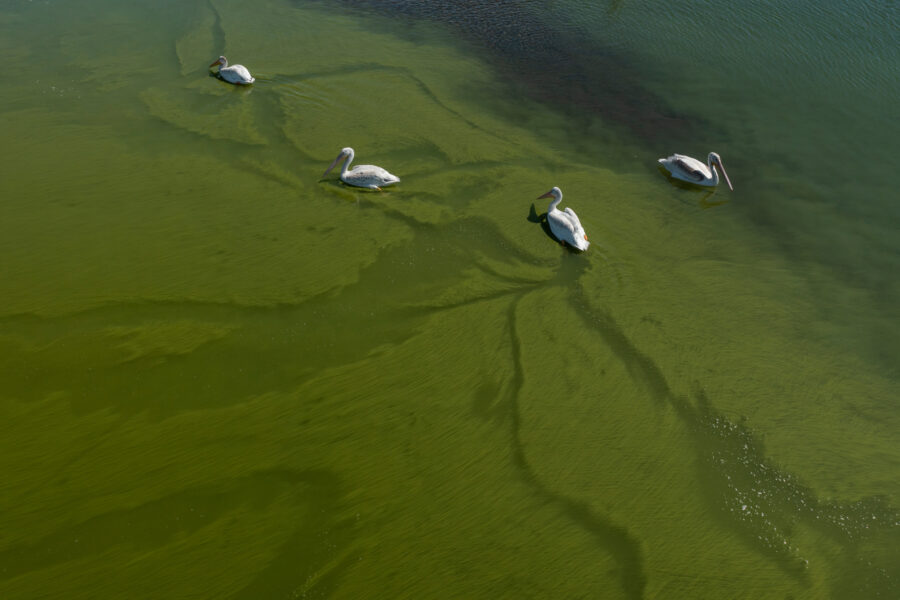Toxic Blooms in New York’s Finger Lakes Set Record in 2024
This article previously appeared in Water Front.
AUBURN, N.Y.—Blooms of toxic cyanobacteria “exploded” across the Finger Lakes this worst-ever season, as Seneca, Canandaigua, Skaneateles and Cayuga lakes each had more than 100 reports of harmful algal blooms, or HABs.
The outbreaks began in June—earlier than ever—and continued through late October. Swaths of streaky green water were widespread, plaguing the lakes for weeks at a time during the season’s peak in September.
“We have had days (in previous years) where the whole lake was ‘lit up,’ but not day after day like this year,” said Bill Roege, president of Seneca Lake Pure Waters Association.
Seneca Lake reported 325 blooms this year, while Canandaigua reported 237, Skaneateles 145 and Cayuga 120, according to the Finger Lakes Regional Watershed Alliance.
Explore the latest news about what’s at stake for the climate during this election season.
The toxins produced by cyanobacteria threaten swimmers, pets and lakeshore homeowners who draw drinking water from the lakes and public water systems.
On Oct. 8, the City of Auburn and the Town of Owasco reported traces of cyanotoxins in their public drinking water for the first time since 2016.
The next day no toxins were detected in either the tap water or the raw water the public systems draw from Owasco Lake, and none have been detected since. The toxins never reached levels considered a threat to public health.
But the readings underscored the fact that the expensive filtering systems the city and town installed in 2017 in response to the tap water crisis in 2016 may not be up to the challenge of protecting the public.
“We sit here on pins and needles (every October) waiting to see what the test results are,” said Auburn Mayor Jimmy Giannettino. “It’s one of the things that keeps me up at night.”
For years, Giannettino and others have ardently demanded more state support to address the threat HABs pose to drinking water. They seek local rules that address agricultural runoff and local enforcement authority to address violations.
The campaign includes a lawsuit filed in January against the state departments of health and agriculture. The suit alleges that the state is too lax in its regulation of farm runoff, which is often loaded with phosphorous and nitrogen that fuel lake blooms. (On Friday, lawyers for the state filed a motion to dismiss the case in the Albany County Supreme Court.)
Owasco Lake provides drinking water to 45,000 people, including residents of Auburn at its northern end. The lake is 10.6 miles long and covers 10.4 square miles, but its watershed spreads over 205 square miles sprinkled with farming communities.
“Owasco Lake is the canary in the coal mine for harmful algal blooms in the Finger Lakes,” said state Sen. Rachel May (D-Syracuse). “The state’s actions to protect Owasco so far are inadequate, and I will keep working to expand them.”
Public water systems throughout the region remain on high alert for toxins produced by cyanobacteria.
“All our water at the intake pipes have come back non-detect,” said Frank Moses, executive director of Skaneateles Lake Association. But officials at the lake that supplies water to Syracuse are “working on a pipe extension deeper into the water column” to reduce the chance of drawing contaminated raw water, he added. Harmful algal bloom reports for Skaneateles leaped from 19 last year to 144 this season.
Canandaigua water districts have eyed raw lake water and finished drinking water since 2018 when tap water in the Village of Rushville showed dangerous levels of microsystins, an algal bloom toxin. A tap water drinking ban forced health officials to organize temporary shipments of bottled water to a local school and fire department.
“Owasco Lake is the canary in the coal mine for harmful algal blooms in the Finger Lakes.”
New York State Sen. Rachel May
For two straight days that October, toxin levels in Rushville’s tap water were more than twice the U.S. Environmental Protection Agency’s 10-day health advisory level of 0.3 micrograms of microcystins per liter for children under six years old. The EPA advisory for other people is 1.6 micrograms per liter.
In late August this year, raw water that the City of Canandaigua drew from its lake contained microcystins at 0.96 micrograms per liter. Although no toxins were detected in three tests in September, all four raw water tests in October showed levels exceeding the 0.3 EPA advisory level.
Also, tests on Oct. 15 showed raw lake water drawn in the districts of Gorham, Newark and Rushville had microsystins at or above the 0.3 EPA advisory level.
So far, the filtering systems have worked. No tests in 2024 detected cyanotoxins in public drinking water drawn from Canandaigua Lake.
The spike in blooms this year led health officials to close many state-run beaches to swimmers. Most beach closings in the Finger Lakes were short-lived, but several beaches were closed more than once.
Other smaller swimming areas managed by towns or counties were not always quick to ban swimming or even to warn swimmers.
“We did have several volunteers share that they came across people and pets swimming in waters when HABs were present,” said Grascen Shidemantle, executive director of the Community Science Institute in Ithaca, which monitors HABs on Cayuga Lake. She said they warned swimmers about the dangerous toxins.
But bathers didn’t always heed the warnings, or even obey signs that beaches were closed due to reported blooms.
The state Department of Health warns: “Stop using (lake) water and consider medical attention if people or animals have symptoms and might have touched, swallowed, or inhaled surface waters with possible blooms. Symptoms include diarrhea, nausea or vomiting; skin, eye or throat irritation; and allergic reactions or breathing difficulties.”
The EPA warns: Department of Health “risks include rashes, hives or skin blisters from skin exposure; airway irritation from inhalation of aerosols; gastroenteritis, liver toxicity, and neurotoxicity from ingestion; illness and death of pets, livestock, wildlife from swimming or ingesting contaminated water.”
But clear examples of health harms are hard to pin down.
Non-profit citizen groups and volunteers trained to spot blooms cite anecdotes of harms, but they don’t track them.
“While we’ve heard second-hand accounts of people and pets experiencing health issues from the Finger Lakes, including some cases of dogs becoming ill or dying, we don’t have first-hand information on whether those were confirmed reports from a medical professional,” said Lindsay McMillan, director of the Canandaigua Lake Watershed Association.
Neither the DOH nor the state Department of Environmental Conservation compile statewide data on specific reports of people or pets harmed by cyanotoxins. They advise checking with local health departments.
The DEC does maintain a useful interactive map that shows reported cyanobacteria blooms with dates and pictures. The agency encourages both trained volunteers and members of the public to submit pictures of potential HABs. The agency confirms a bloom and adds it to the map based on visual evidence from submitted pictures rather than from lab tests.
This year’s proliferation of blooms has heightened concerns among officials at the DOH and lake associations about the health of lakeside property owners who rely on lake water drawn from wells or shallow intake pipes for drinking, showering or dishwashing.
Their water purification systems typically aren’t up to the task of eliminating cyanotoxins. Boiling water doesn’t help, and traditional filters that trap sediment and microbes like e.coli aren’t much use either.
Two systems that can work are activated carbon filtration and reverse osmosis, according to Bruce Capron, a chemical engineer who lives on the west side of Canandaigua Lake.
“Start looking at reverse osmosis if you’re dependent on lake water—at least for your sink,” said Jacob Welch, president of the Finger Lakes Regional Watershed Alliance. “It will take out the HABs poisons. It also takes out PFAS (toxic ‘forever chemicals’ also found in certain lakes).”
Welch said FLRWA is working with political leaders and county soil and water conservation agencies to reduce nutrient-laden runoff into the lakes.
But that’s only a partial solution, he said, because blooms are caused by a complex mix of conditions that include calm warm water, wind and wave action, and even mussel beds.
“Nobody’s got a great solution yet (to reducing HABs),” he added. “Even after all these years of looking at a worldwide problem, we still don’t have that good an understanding of them.”
About This Story
Perhaps you noticed: This story, like all the news we publish, is free to read. That’s because Inside Climate News is a 501c3 nonprofit organization. We do not charge a subscription fee, lock our news behind a paywall, or clutter our website with ads. We make our news on climate and the environment freely available to you and anyone who wants it.
That’s not all. We also share our news for free with scores of other media organizations around the country. Many of them can’t afford to do environmental journalism of their own. We’ve built bureaus from coast to coast to report local stories, collaborate with local newsrooms and co-publish articles so that this vital work is shared as widely as possible.
Two of us launched ICN in 2007. Six years later we earned a Pulitzer Prize for National Reporting, and now we run the oldest and largest dedicated climate newsroom in the nation. We tell the story in all its complexity. We hold polluters accountable. We expose environmental injustice. We debunk misinformation. We scrutinize solutions and inspire action.
Donations from readers like you fund every aspect of what we do. If you don’t already, will you support our ongoing work, our reporting on the biggest crisis facing our planet, and help us reach even more readers in more places?
Please take a moment to make a tax-deductible donation. Every one of them makes a difference.
Thank you,
David Sassoon
Founder and Publisher
Vernon Loeb
Executive Editor
Share this article
- Republish
Disclaimer: The copyright of this article belongs to the original author. Reposting this article is solely for the purpose of information dissemination and does not constitute any investment advice. If there is any infringement, please contact us immediately. We will make corrections or deletions as necessary. Thank you.
Title:Toxic Blooms in New York’s Finger Lakes Set Record in 2024
Url:https://www.investsfocus.com







